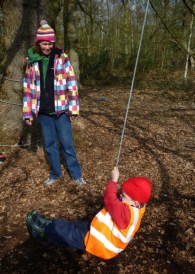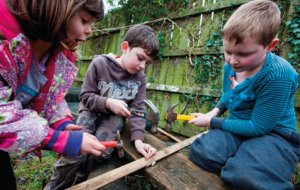This post explores how the real-time decisions of educators, playworkers and other staff who oversee children fit into the overall risk management process, and how they are held to account for those decisions. I have written it at the suggestion of the UK Play Safety Forum. The PSF would welcome comments on the position set out here – as would I.

Bayonne Nursery Forest School session
I will start with describing a real-life scenario from a Forest School session run by Bayonne Nursery a few years ago. (Those who have heard me talk on risk will recognise it from a video clip that I often show.) A group of four-year-old children are exploring an area of woodland. After clearing away fallen branches from around a large tree trunk that crosses over a dry ditch, three girls start to shimmy across. Two succeed, while the third becomes alarmed and gives up. Forest school-trained educators, present throughout, do not intervene at any point – not even to give encouragement or warnings. This is despite the fact that at points, things look like they might be getting challenging, uncomfortable or even slightly dangerous.






